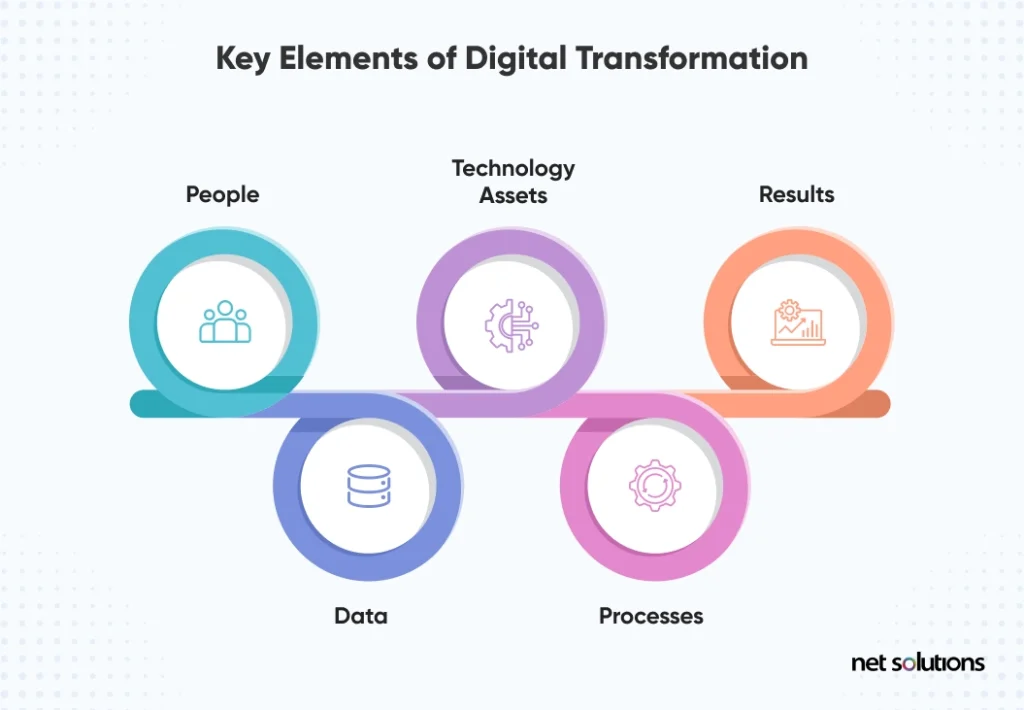Digital transformation isn’t just a matter of upgrading systems and modernizing apps to adapt to new technology—if only it were that easy!
A successful digital transformation project must consider several factors, not the least of which is the human element. Besides technological changes, digital modernization requires a shift in mindset, culture, and business processes.
Failing to consider these things may impact adoption, communication, and overall business operations, ultimately impacting your competitive edge.
This blog post outlines the steps to take in your digital transformation journey, and you can download our Digital Transformation Checklist to guide you as you build and execute your plan.
Download your free Digital Transformation Checklist today!

Key Elements of a Digital Transformation Strategy
Digital transformation involves many moving parts that must work together to produce effective results. It also involves an intelligent approach to keeping up with the latest digital transformation trends.
Emerging Trends in Digital Transformation for Mid-Size Enterprises
Read MoreLet’s explore the essential elements of digital transformation, from culture to technology to measuring results.

1. People
Human beings are at the core of every business initiative, whether that involves a major digital transformation or change to non-tech-centered workflows and processes.
The most cutting-edge technology is worthless unless you’ve got buy-in at all levels of your organization. And getting buy-in on your digital transformation initiative can be challenging because people often resist change.
Your efforts will typically begin with your decision-makers and key stakeholders. They need to understand why you’re adopting new digital technologies and how new technologies will support their business objectives.
Creating and fostering a culture and mindset of continuous learning and innovation will make your digital transformation efforts easier. When they understand the larger mission, people are likely to let go of outmoded manual processes and legacy systems.
Ensure everyone knows your business case for app modernization, infrastructure changes, and improving digital capabilities.
2. Data
Data plays a key role because there is no one-size-fits-all approach to digital transformation initiatives. Collecting the correct data, performing data analytics, and applying everything you’ve learned will help you streamline your efforts and tailor your project to your needs and business model.
Companies that have reached digital maturity incorporate data analytics into their transformation efforts, often drawing on big data, Artificial Intelligence (AI), and Machine Learning (ML) to gain valuable insights.
Establish data as the fundamental pillar of your strategy in making data-driven decisions about your transformation and structuring your new systems to gather and process raw data about your customer and systems.
You can then analyze that data to determine whether you’re hitting key metrics that produce a competitive advantage for your business.
3. Technology assets
Transforming your organization into a cutting-edge digital business means tapping into the latest technology, from cloud computing to automation.
Modern digital platforms help streamline internal processes and enhance the customer experience through better support tracking, faster systems, fewer technical glitches, and easier access to information.
Use cases will vary endlessly from one company to the next. For example, a healthcare company might focus on implementing Internet of Things (IoT) solutions to serve patients better. At the same time, a manufacturer might find more significant benefits in investing in project management software.
However you plan to optimize your business digitally, technology will play a key role.
4. Processes
Strategic processes have played a key role in the high-tech world for many years after innovative IT thought leaders realized they could boost efficiency through superior coordination and systematic processes.
One of the most common software development methodologies is Agile Scrum, which draws from principles first developed in auto manufacturing.
Software development differs from manufacturing because it doesn’t use raw materials, and changes can be tested and refined with every new release. With that in mind, they tweaked methodologies like Lean, adapting them to coding.
Building intelligent processes around your digital transformation will help ensure standardization and continuous improvement.
5. Results
Establishing clear metrics for success for your digital transformation; that way, you can evaluate your efforts and adjust them based on objective results. This means identifying milestones and ensuring you meet them—or digging deep to determine how you fell short so you can improve next time.
Establishing Key Performance Indicators (KPIs) is vital, and you may want to employ other methodologies like road mapping or Objectives and Key Results (OKRs).
Regularly review your change management efforts and apply objective metrics as part of your digital transformation plan. Download your free digital transformation checklist today!
Challenges and Risks of a Digital Transformation
In the IT world, risk is how we describe potential problems that could derail a project or even cause it to fail. It’s essential to identify the digital transformation challenges and potential risks so that you can take steps to mitigate those risks.
Five common digital transformation risks include:
- Failure to gain buy-in from leadership: Gaining buy-in from leadership and stakeholders is vital because they will guide the implementation of your project, allocating labor and monetary resources where appropriate. With proper buy-in, your project will succeed.
- Failure to build a digital culture: Leadership approval isn’t enough. Employees at all levels need to understand the larger mission, that way; they’ll be more enthusiastic about adopting and embracing the technology if proper communication is done.
- Lack of strategy and clarity: Your company may be enthusiastic about its digital transformation, but if you don’t take the time to prioritize your efforts and choose the projects that offer the highest return, it will impact your success.
- Scalability issues: Digital transformation is a long-term strategy, so choose scalable projects and replace legacy systems in the correct order so they play nicely with one another.
- Security threats: You introduce potential threats every time you update a system. Monitor security risks carefully and work with an outsourcing partner if your team lacks the required expertise.
A properly managed digital transformation includes a clear awareness of risks and a carefully considered reduction plan.
Assess the Readiness of Your Organization for Digital Transformation
You’ll need to take specific steps before you begin your digital transformation. Consult the following checklist to ensure you’re ready to implement solutions.
Before beginning your transformation, ensure you’ve done the proper groundwork, including the following items.
- Assess the current state of your IT infrastructure and apps
- Consult stakeholders and leadership
- Conduct surveys and gather feedback about your current internal and external tech challenges.
- Assess the state of your security infrastructure.
- Identify legacy apps that need to be modernized, including any apps that aren’t working well together currently.
- Assess your current in-house skillset.
- Explore the possibility of outside help for any areas your in-house team lacks
- Establish metrics for success and continuous improvement
Download our free digital transformation checklist for a complete list of everything you need to do before, during, and after your digital transformation.

How to Manage Change During a Digital Transformation
Now we return to that first pillar of successful digital transformations: People!
Business transformation can only succeed by paying careful attention to your staff and leadership’s needs, concerns, fears, and fundamental drives.
Change is hard, especially in the workplace. People resist it until you show them how much they have to gain by adopting a new approach.
Here are some tips to help you navigate change management and build a culture supporting digital transformation.
- Evangelize company-wide: Communicate the value of digital transformation efforts to the whole organization.
- Don’t get too technical with non-technical leaders: IT professionals can get lost in the tech weeds, struggling to communicate complex ideas in a way non-techies understand—work to express the big picture and get the leaders onboard.
- Ask for the budget you need: Don’t be shy about asking for the resources you need, financial or otherwise. Communicate to leaders that you’ve researched, and thoroughly explain everything you require.
- Communicate ongoing metrics for success: By laying out your KPIs (along with roadmaps and OKRs if you use them), you’ll demonstrate to leadership and the company that you’re serious about staying on track.
Communication, buy-in, and culture shift are key. No digital transformation can succeed without them!
Looking for a Digital Transformation Partner?
Net Solutions excels in digital transformation services and has been helping businesses modernize the technology infrastructure for decades, helping with app modernization, security, and other essentials.
We’ve worked with the Harvard Business Review, American Golf, internationally respected organizations, and countless startups and midsize companies.
Frequently Asked Questions
A few ways to measure the success of your digital transformation are:
- Calculating Return on Investment (ROI) of your digital transformation efforts.
- Measuring productivity with metrics like error rates, employee satisfaction, and time to completion.
- Measuring customer experience with metrics like customer satisfaction, customer lifetime value, and customer churn.
- Tracking the time to market.
Here are a few tips to help you manage the change that comes with digital transformation:
- Start with a clear vision to stay focused throughout digital transformation.
- Involve all stakeholders to ensure everyone’s on the same page and support your cause.
- Clearly communicate the digital transformation process to avoid confusion.
- Empower employees to adapt changes by providing training and support.
- Track your progress to ensure you’re on the right path.
You must involve your executive leadership, employees, partners, and customers in the digital transformation process.
- Clear vision and strategy
- Executive sponsorship
- Culture of innovation and change
- Data-driven decision making
- Agility and adaptability




